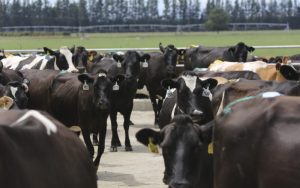
Prices edged up again at last week’s GlobalDairyTrade auction — the last for the year — with an overall price increase of 1.3%.
Gains were strongest for the fat products; butter prices were up 6% and anhydrous milk fat up 1.9% while whole and skim milk powder lifted 0.5% and 1.2% respectively.
ASB economist Nat Keall said the result reflected the fact global demand was still holding up well, providing support for dairy prices.
ASB’s latest forecast placed it in the middle of Fonterra’s milk price range of $6.70-$7.30 which was raised earlier this month.
The big factor to watch now was production over the summer as the weather heated up. The strength of the NZ dollar recently was not likely to be much of a factor from here, given Fonterra’s hedging policies, but was likely to be more of a factor next season, Mr Keall said.
The bank’s forecast revision showed how resilient the dairy sector had been through the Covid-19 pandemic. In March, at the height of Covid-related uncertainty, it thought there was a risk the milk price could go below $6.
Westpac senior agri economist Nathan Penny said the upside risks to the bank’s $7 forecast were rising, and it would ‘‘take stock’’ and review it in the new year.
In its latest Dairy Quarterly report, co-author and senior RaboResearch dairy analyst Emma Higgins said import demand continued to be firm in Asian markets that have successfully controlled Covid-19, and that had contributed to dairy prices staying high throughout the seasonal production peak.
“Plus, we’ve seen the European Private Storage Aid programme whittle down cheese and skim milk powder stocks in the month of October, and these lower European inventories — as well as stock drawdown in the US — are another positive for dairy demand and commodity prices,’’ she said.
Growing consumer confidence in key dairy markets was a further factor supporting optimistic commodity price projections for the coming year, the report said.
“As a challenging 2020 ends, several factors in 2021 aid positive consumer sentiment in key dairy markets. These include the advanced state of several Covid-19 vaccines, less political uncertainty after the US election, a weaker US dollar that aids commodity prices and projections for
economic growth in most regions.”
Despite these factors improving the outlook for global dairy, Ms Higgins said, it was important to note several threats to the global dairy recovery remain.
“While there is optimism regarding Covid-19 vaccines, the pandemic is far from over and we’re currently seeing Covid-19 cases rising in Europe, the US and South America. This is resulting in increased food service restrictions in these countries which will slow the recovery in this sector,” she said.
“The impact of less government support — which has been a key reason for strong demand and healthy trade during the pandemic — could also be significant in the first half of 2021.
‘‘With government subsidies expected to be lower in the year ahead, this could limit demand growth and impact global prices if the economic recovery does not materialise.”
Ms Higgins said a Chinese supply-demand imbalance was a further factor that had the potential to deflate market optimism.























